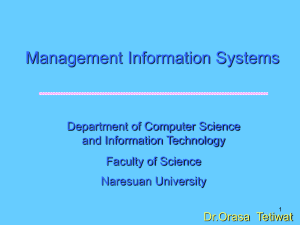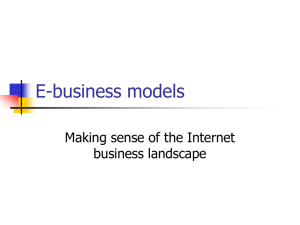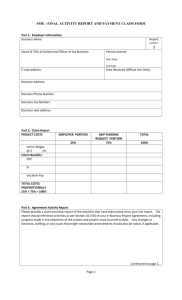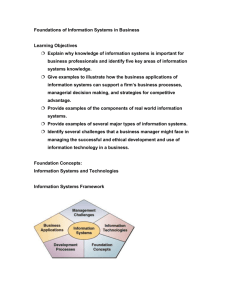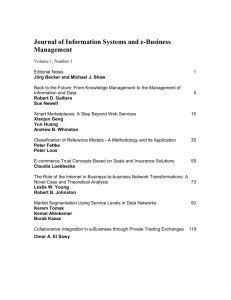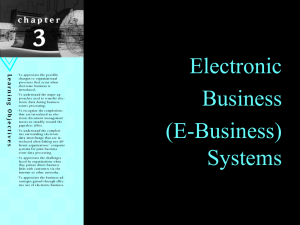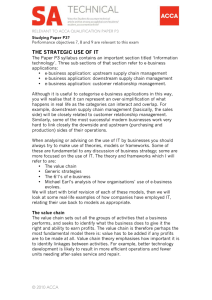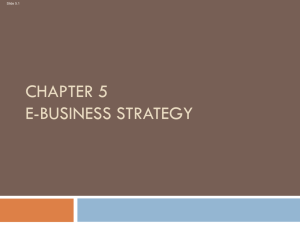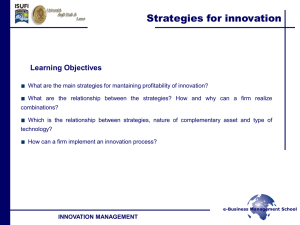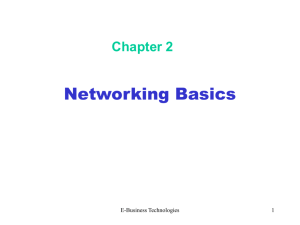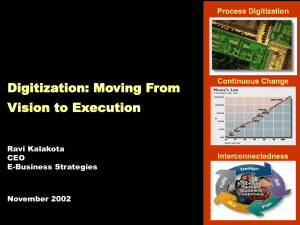Lecture2
advertisement
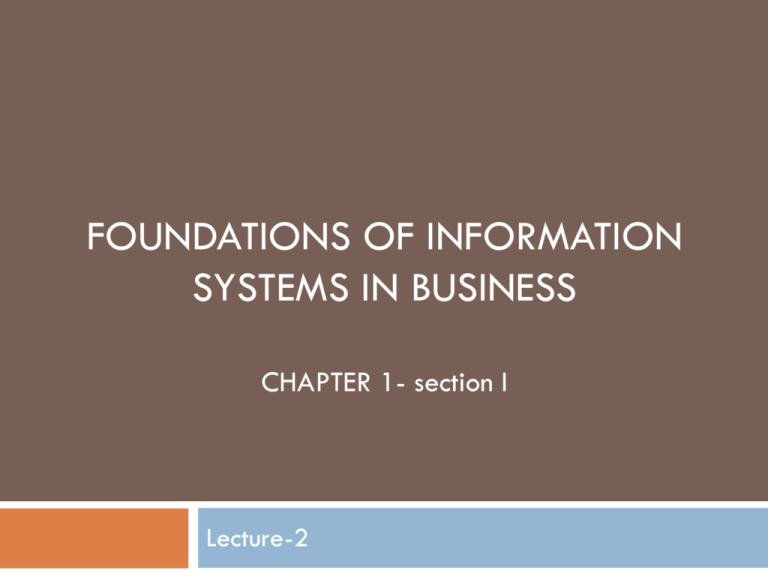
FOUNDATIONS OF INFORMATION SYSTEMS IN BUSINESS CHAPTER 1- section I Lecture-2 Outline • • • • • What is an IS ? The fundamental roles of IS in Business Trends in IS The Role of e-Business in Business Types of IS What is an Information System? Communication networks Policies and procedures People Any organized combination of… Data resources Hardware and software Stores, retrieves, transforms, and disseminates information in an organization Why do we need to understand IS? • Information systems and technologies are vital components of successful business and organizations. The Roles of IS in Business • • Information technologies, including Internet-based IS, are playing vital roles in business. Information technology can help all kinds of business improve the efficiency and effectiveness of their business processes, decision making and workgroup collaboration, which strengthens their competitive positions in rapidly changing marketplace. The Roles of IS in Business Information systems perform three vital roles in any type of organization: 1. Support of business processes and operations. • 2. • 2. • Examples of supported business processes include activities such as: sales transactions, inventory ordering, and payroll processing. Support of decision making by employees and managers. Make decision about activities such as deciding which product lines to add or discontinue. Support of strategies for competitive advantage. Information systems help provide new types of products and services through which an organization might gain a competitive advantage. Fundamental Roles of IS in Business Today’s Focus • Today’s organizations are constantly striving to achieve integration of their systems to allow information to flow freely through them, which adds even greater flexibility and business support than any of the individual system roles could provide. Trends in IS The Role of E-Business in Business • • The Internet have changed the ways businesses operate and people work, as well as how information systems support business process, decision making, and competitive advantage. Thus, many business today are using Internet technologies to Web-enable their business processes and create innovative e-business applications. What is e-Business ? Using Internet technologies to empower… Business processes Electronic commerce Collaboration within a company Collaboration with customers, suppliers, other business stakeholders an online exchange of value E-business applications • Businesses today are using the Internet, corporate intranets, and inter-organizational extranets to support business activities with suppliers, partners, customers, accounting, finance, research and development, manufacturing, marketing, sales, and customer service. How E-Business is Being Used IT in E-business applications The primary Information Technology infrastructure that support the E-business applications of many companies are: 1. Internet 2. Intranet • Internet-like networks and websites developed for use within an organization. Extranet 3. • Internet-like networks that links selected resources of a company with its customers, suppliers, and other business partners using internet technologies. E-Business Applications uses in companies Reengineering Reengineer Internal business processes Enterprise collaboration Electronic commerce Support communication, coordination among teams and work groups Buying, selling, marketing, and servicing of products and services over networks Questions .. Type of Information Systems Types of Information Systems Operations Support systems Transaction processing Process control Enterprise collaboration Management information systems Management Support systems Decision support systems Executive information systems 1- Operations Support Systems These systems help enable the day to day operations of an organization Transaction processing Process control Enterprise collaboration Operations Support Systems Transaction processing systems 1. process routine business transactions, update operational databases, and produce business documents. Examples: sales or purchases. Two Ways to Process Transactions Batch Processing Online Processing Accumulate transactions over time and then process periodically Process all transactions immediately Ex: Banks process all checks in a batch at night Ex: A bank processes ATM withdrawals immediately Types of Operations Support Systems Process control systems 2. These systems monitor and control physical processes Examples: heating and cooling systems. Enterprise collaboration systems 3. Support team or workgroup communications and productivity. Examples: e-mail, instant messaging, message boards, digital whiteboards, wikis, and videoconferencing. 2- Management Support Systems Provide information and support for effective decision making by managers Management information systems Decision support systems Executive information systems Types of Management Support Systems Management Information Systems (MIS) 1. Provide information in the form of reports and displays Example: daily sales analysis reports Decision Support Systems (DSS) 2. Interactive ad hoc support Example: a what-if analysis to determine where to spend advertising dollars Executive Information Systems (EIS) 3. Critical information for executives and managers Example: actions of competitors Other Classifications of Information Systems Expert Systems Knowledge Management Systems Provides expert advice Ex. Credit application advisor Creation, organization, dissemination of knowledge throughout company Customer problems solutions systems Other Classifications of Information Systems Strategic Information Systems Helps get strategic advantage Functional Business Systems Focus on operational and managerial application of basic business functions Ex. Shipment tracking Accounting, finance, marketing Classifications of Information Systems Questions .. Resources .. Read from Chapter 1 (Section 1)
